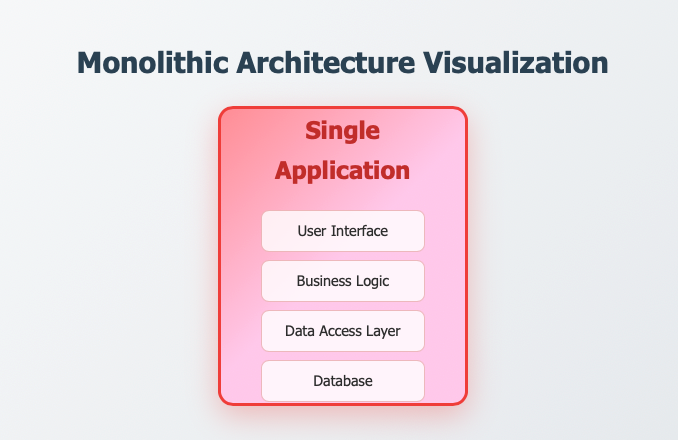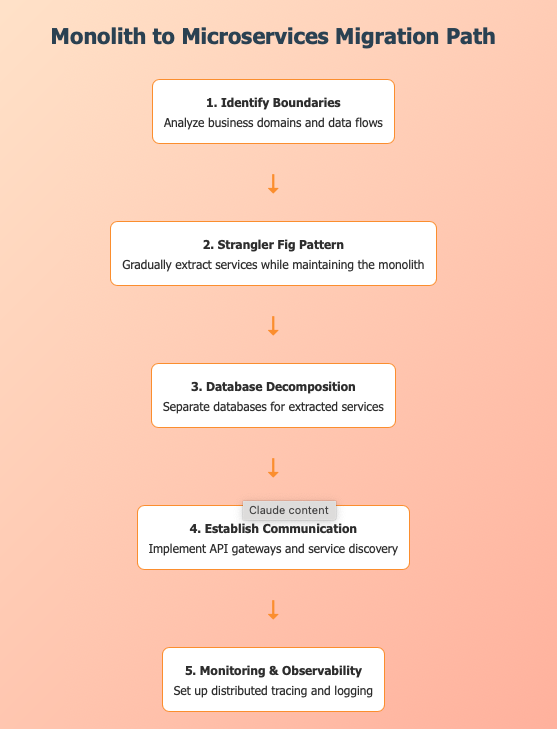
In the rapidly evolving landscape of software architecture, Infrastructure vs Monoliths is one of the most critical decisions development teams face. Choosing between microservices infrastructure and monolithic architecture can significantly impact your application’s scalability, maintainability, deployment strategies, and overall development experience.
Both architectural patterns have their strengths and weaknesses, and the right choice depends on various factors including team size, project complexity, scalability requirements, and organizational structure. Let’s dive deep into understanding these two approaches and when to use each one.
Understanding Monolithic Architecture

A monolithic architecture represents a traditional approach where an entire application is built as a single, unified unit. All components, features, and functionalities are tightly integrated within one codebase and deployed together as a single package.
In a monolithic system, the user interface, business logic, data access layers, and database interactions all exist within the same application boundary. This means that any change, regardless of how small, requires rebuilding and redeploying the entire application.
Key Characteristics of Monoliths
Monolithic applications typically feature a single deployment unit, shared database, synchronized development cycles, and centralized logging and monitoring. The entire application runs in a single process, making inter-component communication straightforward through in-process method calls.
Understanding Microservices Architecture

Microservices architecture breaks down an application into multiple small, independent services that communicate over well-defined APIs. Each service is responsible for a specific business function and can be developed, deployed, and scaled independently.
This approach promotes loose coupling between services, allowing teams to work independently, choose different technologies for different services, and deploy updates without affecting the entire system. Each microservice typically has its own database and handles a specific business domain.
Key Characteristics of Microservices
Microservices feature independent deployments, decentralized data management, technology diversity, fault isolation, and distributed system complexity. Services communicate through network calls, typically using REST APIs, message queues, or event streaming platforms.
Detailed Comparison
| Aspect | Monolithic Architecture | Microservices Architecture |
|---|---|---|
| Development Speed | Fast initial development, slower as codebase grows | Slower initial setup, faster parallel development |
| Deployment | Single deployment unit, all-or-nothing | Independent service deployments |
| Scalability | Scale entire application together | Scale individual services independently |
| Technology Stack | Single technology stack for entire app | Different technologies per service |
| Team Structure | Single team or coordinated teams | Multiple independent teams |
| Testing | Simpler integration testing | Complex distributed system testing |
| Monitoring | Centralized logging and monitoring | Distributed tracing and monitoring |
| Data Management | Centralized database | Decentralized data per service |
Monolithic Architecture: Pros and Cons
Advantages
- Simple development and deployment process
- Easier debugging and testing
- Better performance for small to medium applications
- Simpler monitoring and logging
- ACID transactions across the entire application
- Lower operational complexity
- Faster initial development
- Single codebase to maintain
Disadvantages
- Limited scalability options
- Technology lock-in
- Large codebase becomes difficult to maintain
- Single point of failure
- Deployment of small changes requires full redeployment
- Difficult to scale development teams
- Resource waste when scaling
- Slower feature delivery in large applications
Microservices Architecture: Pros and Cons
Advantages
- Independent scaling of individual services
- Technology diversity and flexibility
- Fault isolation and resilience
- Independent team development
- Easier to understand individual services
- Faster deployment of individual features
- Better alignment with business domains
- Improved resource utilization
Disadvantages
- Increased operational complexity
- Network latency and communication overhead
- Distributed system challenges
- Complex testing and debugging
- Data consistency challenges
- Higher infrastructure costs initially
- Service discovery and load balancing complexity
- Requires mature DevOps practices

When to Choose Each Architecture
Choose Monolithic Architecture When:
- Starting a new project: Monoliths are perfect for MVP development and early-stage applications where requirements are still evolving
- Small team size: Teams with fewer than 10 developers can effectively manage a monolithic codebase
- Simple application: Applications with straightforward business logic and limited complexity
- Limited resources: When you have constraints on infrastructure, DevOps expertise, or budget
- Tight coupling requirements: When business processes are inherently coupled and require ACID transactions
- Performance critical: When low latency is crucial and network overhead must be minimized
Choose Microservices Architecture When:
- Large, complex applications: Systems with multiple distinct business domains and complex workflows
- Multiple teams: Organizations with several development teams that need to work independently
- Scalability requirements: Applications with varying load patterns across different features
- Technology diversity needs: When different services would benefit from different technology stacks
- Mature DevOps culture: Organizations with strong CI/CD, monitoring, and operational practices
- Fault tolerance requirements: Systems that need to remain operational even when individual components fail
Migration Strategies

he strangler fig pattern is often the most effective approach for migrating from monolith to microservices. This involves gradually extracting functionality into separate services while keeping the existing monolith running. New features can be built as microservices, and existing features can be extracted over time.
It’s important to note that migration should be driven by business needs, not technology trends. Many successful applications continue to operate effectively as monoliths, and unnecessary migration can introduce complexity without corresponding benefits.
Best Practices and Considerations
For Monolithic Applications:
Focus on maintaining clean architecture with well-defined modules and boundaries. Use dependency injection, implement proper layering, and maintain good test coverage. Consider using feature flags for gradual rollouts and implement comprehensive monitoring even within the monolith.
For Microservices Applications:
Invest heavily in automation, monitoring, and DevOps practices. Implement circuit breakers, retries, and timeout mechanisms for resilience. Design for failure from the beginning, use asynchronous communication where possible, and maintain service contracts carefully. Implement comprehensive logging and distributed tracing.
Common Anti-patterns to Avoid:
Don’t create microservices that are too small (nano-services) or too large (distributed monoliths). Avoid shared databases between services, don’t neglect the operational complexity, and resist the urge to migrate without clear business justification. Remember that distributed monoliths combine the worst aspects of both approaches.
Conclusion
The choice between microservices infrastructure and monolithic architecture isn’t about which is universally better, it’s about which approach better aligns with your specific context, requirements, and organizational capabilities.
Monolithic architecture excels in simplicity, performance, and ease of development for smaller applications and teams. It’s an excellent choice for startups, MVPs, and applications where the business domain is well-understood and relatively simple.
Microservices architecture shines in complex, large-scale applications where independent scaling, technology diversity, and team autonomy are crucial. However, it requires significant investment in tooling, processes, and expertise.
Remember that architecture is not permanent. Many successful companies have started with monoliths and gradually evolved to microservices as their needs changed. The key is to make an informed decision based on your current context while designing for future evolution.
Key Takeaway
Start with the simplest architecture that meets your current needs. Premature optimization toward microservices can introduce unnecessary complexity, while prematurely sticking with monoliths can limit growth. Design your systems to be evolvable, and be prepared to adapt your architecture as your organization and requirements mature.
Stop Wasting Time on Servers. Start Building Instead.
You didn’t start your project to babysit servers. Let ServerAvatar handle deployment, monitoring, and backups — so you can focus on growth.
Deploy WordPress, Laravel, N8N, and more in minutes. No DevOps required. No command line. No stress.
Trusted by 10,000+ developers and growing.
